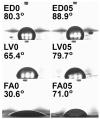Effect of the Addition of Graphene Flakes on the Physical and Biological Properties of Composite Paints
- PMID: 37630425
- PMCID: PMC10458452
- DOI: 10.3390/molecules28166173
Effect of the Addition of Graphene Flakes on the Physical and Biological Properties of Composite Paints
Abstract
In this study, graphene flakes were obtained using an electrolytic method and characterized using X-ray diffraction (XRD), Raman and FTIR spectroscopy, scanning and transmission electron microscopy (SEM/TEM). Graphene-based composites with varying concentrations of 0.5%, 1% and 3% by weight were prepared with acrylic paint, enamel and varnish matrices. The mechanical properties were evaluated using micro-hardness testing, while wettability and antimicrobial activity against three pathogens (Staphylococcus aureus 33591, Pseudomonas aeruginosa 15442, Candida albicans 10231) were also examined. The results indicate that the addition of graphene flakes significantly enhances both the mechanical and antimicrobial properties of the coatings.
Keywords: acrylic paint; antimicrobial properties; composite paints; enamel; graphene flakes; micro-hardness; varnish; wettability.
Conflict of interest statement
The authors declare no conflict of interest.
Figures






References
-
- Jiang J.-W., Wang J.-S., Li B. Young’s Modulus of Graphene: A Molecular Dynamics Study. Phys. Rev. B. 2009;80:113405. doi: 10.1103/PhysRevB.80.113405. - DOI
-
- Paszkiewicz S. Synergiczny Efekt Poprawy Przewodnictwa Elektrycznego w Hybrydowych Nanokompozytach Polimerowych z Udziałem Nanocząstek Węglowych 1D i 2D. Inżynieria Mater. 2015;1:10–13. doi: 10.15199/28.2015.5.2. - DOI
-
- Sukumaran L. A Study of Graphene. Int. J. Educ. Manag. Eng. 2014;4:9–14. doi: 10.5815/ijeme.2014.01.02. - DOI
-
- Taqi-Uddeen Safian M., Umar K., Nasir M., Ibrahim M. Synthesis and Scalability of Graphene and Its Derivatives: A Journey towards Sustainable and Commercial Material. J. Clean. Prod. 2021;318:128603. doi: 10.1016/j.jclepro.2021.128603. - DOI
MeSH terms
Substances
Grants and funding
LinkOut - more resources
Full Text Sources

